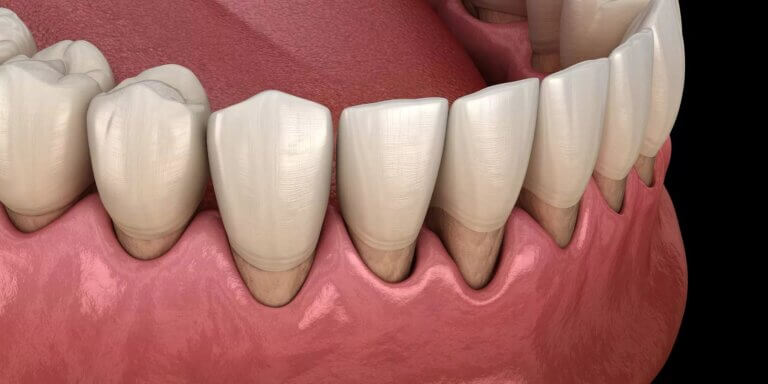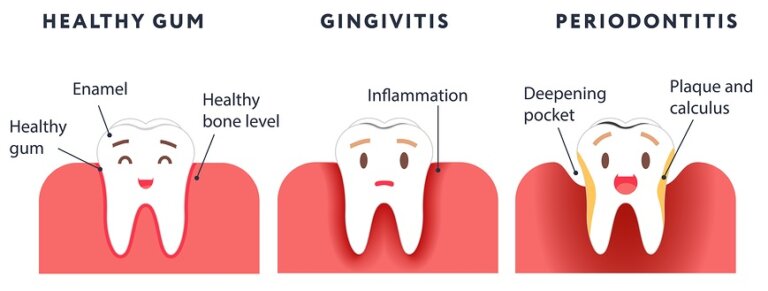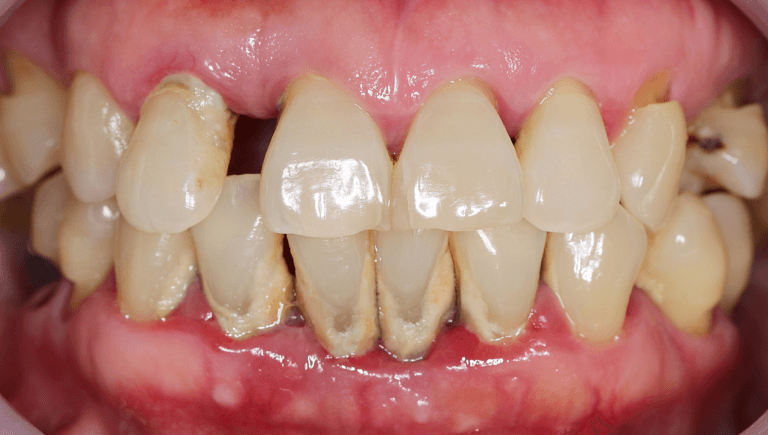Gum Disease

What Is Gum Disease?
Gum disease, also known as periodontal disease or periodontitis, is a common dental problem that affects millions of people worldwide. Periodontitis is largely preventable and is usually the result of poor oral hygiene and buildup of plaque and tartar on teeth over a long period of time, which can lead to inflammation and infection of the gums and alveolar bone. Gum disease can range from mild gingivitis to severe periodontitis, which can cause tooth loss and other health complications if left untreated.
Before you contact a Toronto dentist to examine possible Gum Disease, there are some things you should know as a patient:
- What Is The Difference Between Gingivitis And Periodontitis?
- Why Do I Have Gum Disease?
- Signs And Symptoms Of Gum Disease
- Treatment Options For Gum Disease
- How To Prevent Gum Disease?
- Managing Gum Disease Until You Can See The Dentist
If you have questions about Gum Disease or other dental problems, please contact us for more information.
What Is The Difference Between Gingivitis And Periodontitis?
Gum disease is a progressive condition that can range from mild gum inflammation, known as gingivitis, to a more severe and chronic infection called periodontitis. Although periodontitis is a more severe form of gum disease, all cases of periodontitis begin with gingivitis.
In the early stages of gingivitis, bacteria-filled plaque builds up on the gum line, causing the gums to become swollen, inflamed, and easily prone to bleeding. However, the teeth remain firmly embedded in the bone, and there is no irreversible damage to the gums or bone at this stage. Proper oral hygiene, including brushing and flossing, can help reverse gingivitis and restore healthy gums without any permanent damage.
If left untreated, plaque can harden over time and become tartar or calculus, making it more challenging to clean teeth and gums effectively without professional help. As the disease progresses, the gums’ pathological pockets grow deeper, and more gum tissue and bone are destroyed, leading to irreversible destruction of the gum and bone supporting the teeth. The bacteria in plaque and calculus produce toxins that are harmful to the gums, and the immune system tries to fight the infection by producing enzymes. Together, these toxins and enzymes break down bone and connective tissues that hold teeth in place. As a result, teeth become loose, and tooth loss can follow. In fact, gum disease is the leading cause of tooth loss in adults.
Therefore, it’s crucial to maintain proper oral hygiene and seek professional dental care if you experience symptoms of gum disease, such as swollen or bleeding gums, bad breath, or loose teeth. Early detection and treatment of gum disease can help prevent irreversible damage and preserve your oral health. If you have further questions about Gum Disease or gingivitis, please contact us.

Why Do I Have Gum Disease?
Gum disease can have several causes, including:
- Poor Oral Hygiene: Failing to brush and floss regularly can allow plaque and tartar to accumulate on teeth, which can lead to gum disease.
- Smoking and Tobacco Use: Smoking and using tobacco products can weaken the immune system and cause gum inflammation, making it easier for gum disease to develop.
- Genetics: Some people may have a genetic predisposition to gum disease, which can make them more susceptible to developing the condition.
- Medications: Certain medications, such as antidepressants and blood pressure medications, can cause dry mouth and decrease saliva production, which can increase the risk of gum disease.
- Health Conditions: Health conditions such as diabetes, heart disease, and HIV/AIDS can increase the risk of developing gum disease.
- Hormonal Changes: Hormonal changes during pregnancy, puberty, and menopause can make gums more sensitive and increase the risk of gum disease.
By understanding the potential causes of gum disease, you can take steps to prevent and manage the condition. It is important to maintain good oral hygiene, avoid smoking and tobacco use, and manage any underlying health conditions to reduce the risk of gum disease. If you have further questions about Gum Disease, please contact us.
Signs And Symptoms Of Gum Disease
Gum disease can present several signs and symptoms, including:
- Red, Swollen, or Tender Gums: Gums that are inflamed, red, or tender to the touch are common signs of gum disease.
- Bleeding Gums: Bleeding gums when brushing, flossing, or eating can be a sign of gum disease.
- Receding Gums: Gums that are pulling away from the teeth can be a sign of advanced gum disease.
- Persistent Bad Breath: Bad breath that doesn’t improve with brushing, flossing, or mouthwash can be a sign of gum disease.
- Loose or Separating Teeth: Gum disease can cause the bone and tissues that support the teeth to break down, leading to loose or separating teeth.
- Changes in Bite: Changes in the way your teeth fit together when biting down can be a sign of gum disease.
If you are experiencing any of these symptoms, it is important to schedule a dental appointment as soon as possible. Early detection and treatment of gum disease can prevent the condition from progressing and causing further damage to your teeth and gums. If you have further questions about the signs or symptoms of Gum Disease, please contact us.
Treatment Options For Gum Disease
The treatment for gum disease will depend on the severity of the condition, but options may include:
- Professional Cleaning: A professional cleaning by a dental hygienist can remove plaque and tartar buildup, helping to treat mild to moderate gum disease.
- Scaling and Root Planing: Scaling and root planing is a deep cleaning procedure that removes plaque and tartar from below the gum line and smooths the root surfaces to help prevent future buildup.
- Antibiotics: Antibiotics may be prescribed to help treat gum infections or prevent the infection from spreading.
- Gum Surgery: In severe cases of gum disease, surgery may be necessary to remove infected tissue or reshape the gums to promote healing.
- Bone and Tissue Grafts: In some cases, bone or tissue grafts may be needed to restore damaged bone or gum tissue.
It is important to work with your dental professional to determine the best treatment plan for your individual needs. In addition to professional treatment, maintaining good oral hygiene habits at home, such as brushing and flossing regularly and using an antiseptic mouthwash, can help prevent gum disease from recurring. If you have further questions about treatment options for Gum Disease, please contact us.

How To Prevent Gum Disease?
Preventing gum disease requires a combination of good oral hygiene habits and regular dental check-ups. Here are some ways to prevent gum disease:
- Brush Twice Daily: Brushing your teeth twice a day for at least two minutes each time can help remove plaque and prevent the tartar buildup.
- Floss Daily: Flossing at least once a day can help remove plaque and food particles from between teeth and along the gum line.
- Use Mouthwash: Using an antiseptic mouthwash can help kill bacteria and freshen your breath.
- Quit Smoking: Quitting smoking and using tobacco products can improve your oral health and reduce the risk of gum disease.
- Eat a Balanced Diet: Eating a balanced diet rich in vitamins and nutrients can help promote healthy gums and prevent gum disease.
- Schedule Regular Dental Check-Ups: Regular dental check-ups can help detect and treat gum disease early, before it progresses and causes more damage.
By following these tips, you can reduce your risk of developing gum disease and maintain good oral health. If you are experiencing any signs or symptoms of gum disease, schedule an appointment with your dental professional as soon as possible. If you have further questions about treating or preventing Gum Disease, please contact us.
Managing Gum Disease Until You Can See The Dentist
If you are experiencing signs or symptoms of gum disease and are unable to see a dentist right away, there are some steps you can take to manage the condition at home:
- Brush and Floss Regularly: Brush your teeth twice a day and floss once a day to remove plaque and prevent the tartar buildup.
- Rinse with Saltwater or Mouthwash: Rinsing your mouth with warm salt water or mouthwash can help reduce infection, inflammation and alleviate toothache pain. You can buy any mouthwash available at your pharmacy or health foods store. Alternatively, you can mix a teaspoon of salt in a cup of warm water and swish the solution around your mouth for about 30 seconds before spitting it out.
- Use Over-the-Counter Pain Medication: Over-the-counter pain medication, such as Advil (ibuprofen) or Tylenol (acetaminophen), can help relieve pain from gum disease and reduce inflammation. Follow the instructions on the label and do not exceed the recommended dose. Unless you have a health condition that prevents you from taking either ibuprofen or acetaminophen, the absolute maximum dose that I recommend patients take for the worst dental pain is 600 mg ibuprofen combined with 1000 mg acetaminophen every 4 to 6 hours.
- Apply a Cold Compress: Placing an ice pack or cold compress on the affected area can help reduce swelling and numb the pain. Wrap the ice pack in a cloth and apply it to your cheek for 15-20 minutes at a time.
- Avoid Hard, Crunchy Foods: Avoid hard, crunchy foods that can irritate your gums and cause further damage. Stick to soft foods like soup, yogurt, or mashed potatoes to avoid aggravating the affected area. When eating food, favor the side that is not causing you pain so to avoid further irritating the affected side.
- Quit Smoking: If you smoke or use tobacco products, quit as soon as possible to improve your oral health and reduce the risk of further damage.
While these steps can help manage the symptoms of gum disease, it is important to schedule a dental appointment as soon as possible to receive professional treatment and prevent the condition from worsening. If you have further questions about managing pain related to Gum Disease, please contact us.

